Norwegian Royal Family
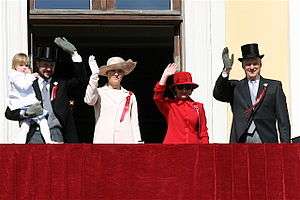
The Norwegian Royal Family is the family of the Norwegian monarch. In Norway there is a distinction between the Royal House and the Royal Family. The Royal House includes only the monarch and his or her spouse, the heir apparent and his or her spouse, and the heir apparent's eldest child. The remaining Royal Family includes also all other children, grandchildren, step(grand)children and siblings of the monarch, along with their spouses and widows or widowers.[1]
| Norwegian Royalty House of Oldenburg (Glücksburg branch) |
|---|
 |
| Haakon VII |
|
| Olav V |
| Harald V |
|
Members
Members of the Royal Family (with names of the members of the Royal House in bold letters) are:
- King Harald V
- Queen Sonja (the King's wife)
- Crown Prince Haakon (the King's son)
- Crown Princess Mette-Marit (the King's daughter-in-law)
- Princess Ingrid Alexandra (the King's granddaughter)
- Prince Sverre Magnus (the King's grandson)
- Marius Borg Høiby (the King's step-grandson)
- Princess Märtha Louise (the King's daughter)
- Ari Behn (the King's son-in-law)
- Maud Angelica Behn (the King's granddaughter)
- Leah Isadora Behn (the King's granddaughter)
- Emma Tallulah Behn (the King's granddaughter)
- Erling Lorentzen (the King's brother-in-law, widower of Princess Ragnhild)
- Princess Astrid, Mrs. Ferner (the King's sister)
Deceased members
Deceased members of the Royal Family are:
- Queen Maud (d. 1938) (the King's grandmother)
- Crown Princess Märtha (d. 1954) (the King's mother)
- King Haakon VII (d. 1957) (the King's grandfather)
- King Olav V (d. 1991) (the King's father)
- Princess Ragnhild (d. 2012) (the King's sister)
- Johan Ferner (d. 2015) (the King's brother-in-law, husband of Princess Astrid)
Family tree of members
| King Olav V | Princess Märtha, Crown Princess of Norway | ||||||||||||||||||||||||||||||||||||||||||||||||||||||||||
| Erling Lorentzen | Princess Ragnhild, Mrs. Lorentzen | Johan Martin Ferner | Princess Astrid, Mrs. Ferner | The King* | The Queen* | ||||||||||||||||||||||||||||||||||||||||||||||||||||||
| Ari Behn | Princess Märtha Louise | The Crown Prince* | The Crown Princess* | ||||||||||||||||||||||||||||||||||||||||||||||||||||||||
| Maud Angelica Behn | Leah Isadora Behn | Emma Tallulah Behn | Princess Ingrid Alexandra* | Prince Sverre Magnus | Marius Borg Høiby | ||||||||||||||||||||||||||||||||||||||||||||||||||||||
- Notes
* Member of the Royal House
Royal coat of arms
The coat of arms of Norway is one of the oldest in Europe and serves both as the coat of arms of the nation and of the Royal House. This is in keeping with its origin as the coat of arms of the kings of Norway during the Middle Ages.[2]
Håkon the Old (1217–1263) used a shield with a lion. The earliest preserved reference to the colour of the arms is the King's Saga written down in 1220.[2]
In 1280 King Eirik Magnusson added the crown and silver axe to the lion.[2] The axe is the martyr axe of St. Olav, the weapon used to kill him in the battle of Stiklestad in 1030.
The specific rendering of the Norwegian arms has changed through the years, following changing heraldic fashions. In the late Middle Ages, the axe handle gradually grew longer and came to resemble a halberd. The handle was usually curved in order to fit the shape of shield preferred at the time, and also to match the shape of coins. The halberd was officially discarded and the shorter axe reintroduced by royal decree in 1844, when an authorized rendering was instituted for the first time. In 1905 the official design for royal and government arms was again changed, this time reverting to the medieval pattern, with a triangular shield and a more upright lion.[2]
The coat of arms of the royal house as well as the Royal Standard uses the lion design from 1905. The earliest preserved depiction of the Royal Standard is on the seal of Duchess Ingebjørg from 1318.[3] The rendering used as the official coat of arms of Norway is slightly different and was last approved by the king 20 May 1992.[4]
When used as the Royal coat of arms the shield features the insignias of the Royal Norwegian Order of St. Olav around it and is framed by a royal ermine robe, surmounted by the crown of Norway.
The Royal coat of arms is not used frequently. Instead, the king's monogram is extensively used, for instance in military insignia and on coins.
-
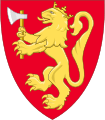
Arms of Norway
-

Royal Coat of Arms of Norway
-
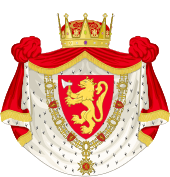
Coat of Arms of the Crown Prince of Norway
-

Royal Monogram of King Haakon VII of Norway
-

Royal Monogram of Queen Maud of Norway
-

Royal Monogram of King Olav V of Norway
-

Royal Monogram of Princess Märtha of Norway
-

Royal Monogram of King Harald V of Norway
-
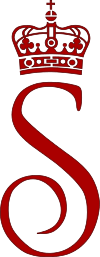
Royal Monogram of Queen Sonja of Norway
-

Royal Monogram of Crown Prince Haakon of Norway
-

Royal Monogram of Crown Princess Mette-Marit of Norway
-
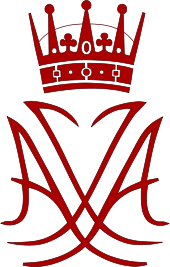
Royal Monogram of Princess Ingrid Alexandra of Norway
-

Royal Monogram of Prince Sverre Magnus of Norway
See also
- Kings of Norway family tree
- Line of succession to the Norwegian throne
- List of Norwegian monarchs
- Monarchy of Norway
References
- ↑ "The Royal Family". www.royalcourt.no. Norwegian Royal Court.
- 1 2 3 4 A web page featuring the history of the coat of arms of Norway Retrieved 21 November 2006
- ↑ An article from the Norwegian National Archives depicting the seal of Duchess Ingebjørg (Norwegian) Retrieved 5 November 2007
- ↑ Web page on rules for the use of the coat of arms (Norwegian) Retrieved 21 November 2006
External links
- -Official Twitter account
- -Official Facebook account
- The Royal Family and the Royal House of Norway - Official Site of the Norwegian Royal Family (in English)
- The Royal House of Norway - Official Site of the Royal House of Norway (Entire Site in English)